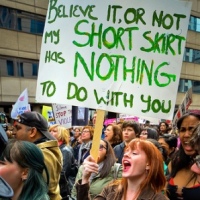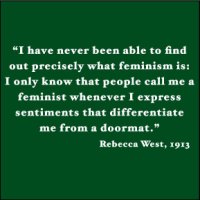A Review Essay of Everyday Pornography, edited by Karen Boyle (New York: Routledge, 2010) and Pornland: How Porn Has Hijacked Our Sexuality, by Gail Dines (Boston: Beacon, 2010)
by Ronald Weitzer
In an earlier article in this journal, I critiqued a particular theoretical approach to prostitution, what I call the “oppression paradigm” (Weitzer, 2005; see also Weitzer, 2010). The present review extends this critique to some recent books on pornography, both of which are grounded in the oppression paradigm—a perspective that depicts all types of sex work as exploitative, violent, and perpetuating gender inequality. This paradigm does not hold that exploitation and violence are variables—present in varying degrees or absent in some kinds of sexual commerce—but are instead constants central to the very definition of pros- titution, pornography, and stripping. I have argued that those who adopt the oppression paradigm substitute ideology for rigorous empirical analysis and that their one-dimensional arguments are contradicted by a wealth of social science data that shows sex work to be much more variegated structurally and experientially (Weitzer, 2009).
The books under review make no pretense of being fair and balanced analyses of pornography. Several of the authors are self-described antiporn activists and, given their strong political views on the subject, it is no surprise that they are critical of pornography, say nothing positive about it, and offer sweeping generalizations to condemn it….
Gail Dines is an academic and well-known antiporn activist. For her, pornography is dangerous and has far-reaching effects on society: “As long as we have porn, [women] will never be seen as full human beings deserving of all the rights that men have” (p. 165). Her book, Pornland, echoes much of Boyle’s book in its arguments. What are Dines’ core claims?
1. Porn is becoming steadily mainstreamed, “infiltrating” the wider culture. This has happened to such an extent that we are now living in the midst of a “porn culture.” “Porn is now so deeply embedded in our culture that it has become synonymous with sex” (p. x). Dines’ examples of this mainstreaming include young girls’ sexy attire, women’s genital waxing (which began in porn), magazines such as Cosmopolitan and Maxim, music videos adorned with scantily clad women, shows such as Sex in the City, websites such as Girls Gone Wild, and “hookup sex” between young people which “is a lot like porn sex” (p. 114). There is no doubt that Western culture has grown increasingly sexualized in the past 20 years (Attwood, 2006). But it is a separate question (a) whether this trend is a bad thing, as Dines thinks it is, and (b) the extent to which pornography is responsible for this broader sexual- ization, a claim that is only sketchily documented in the book.
2. Dines imagines that there is a distinct category of “porn sex.” Porn sex is “debased, dehumanized, formulaic, and generic” (p. x). It differs from proper sex, which she defines as involving “empathy, tenderness, caring, affection” and “love, respect, or connection to another human being” (pp. xxiv, xi).
3. Porn is almost universally “degrading,” “dehumanizing,” and violent, with women as victims and men as perpetrators. “In porn the man makes hate to the woman, as each sex act is designed to deliver the maximum amount of degradation” (p. xxiv). Women in porn do not experience pleasure, “rarely” receive oral sex, lack agency, and are simply vehicles for men’s satisfaction (p. xxiii).
4. Pornography itself has become increasingly extreme: “what used to be considered hard-core is now mainstream pornography” (p. xvii). “Body-punishing” sex is now the norm, meaning that it typically involves very rough sex harmful to women’s bodies.
5. The slippery slope: Men who watch porn become “desensitized” and seek ever more extreme porn to satisfy themselves. Dines declares that “users need to eventually seek out more extreme acts as a way to keep them interested and stimulated . . . heightening the level of degradation is what keeps men interested in and aroused by porn” (p. 68). Inevitably, it seems, men “end up masturbating to images that had previously disgusted them,” including bondage, violence, and child porn (pp. 93, 94).
6. Porn has strong, unequivocal effects on viewers: Viewers are passive recipients who do not actively engage with and interpret messages and meanings. Porn “leaves little room for multiple interpretations” (p. 86), something media scholars would find outlandish. Dines rejects the notion that viewers are “sophisticated consumers who enjoy porn for the playful fantasy it is” (p. 82). This is a fiction created by the porn industry. It is “fantastical thinking that men can masturbate to porn images and walk away from them untouched by the misogyny” (p. 78). “The stories seep into the very core of their sexual identity” (p. xxii); “the ability to keep porn women separate from the women they date is eroded” (p. 67); men are “trained by the porn culture to see sex as disconnected from intimacy” (p. 92); and “porn trains men to become desensitized to women’s pain” (p. 74). The porn industry is depicted as “predatory,” preying on men and “hijacking” their sexuality (pp. xi, xii).
The Evidence
To evaluate these claims, it is crucial to ask if there is supporting evidence. Like Boyle’s book, Dines’ is evidence-thin. Although Dines cites a handful of academic studies, vir- tually the entire book is based on anecdotal information: (a) quotations from some men and women who attend Dines’ lectures; (b) her descriptions of some porn websites; (c) statements from a handful of actors and producers whom Dines met at the annual Adult Expo convention in Las Vegas; and (d) her accounts of selected scenes in porno- graphic videos. How does Dines use this impressionistic material and what alternative sources would be superior?
First, Dines did not conduct a systematic and rigorous review of porn websites or scenes, nor does she cite studies that do so. Neither are readers told how many websites or scenes she examined, nor how they were selected. Did she view 20 scenes or 2,000? She claims that they were representative—“these images are all too representative of what is out there on the Internet and in mass-produced movies” (p. xxi)—but we have no basis for believing that they were. With so much porn available today on the Internet and elsewhere, how could we ever construct a random sample from this universe to reach generalizable conclusions?
Older content analyses found that most pornography in videos and magazines was nonviolent (Scott & Cuvelier, 1987, 1993), and that the most sexually explicit or hard- core videos contained the least violence and the most reciprocal, egalitarian behavior between the actors (Palys, 1986). It is an open question how much violence exists in con- temporary, Internet porn, but there is no doubt that today’s porn is much more varied than what Dines claims.
Second, grand generalizations are made throughout the book. Dines frequently refers to “men,” “women,” the “porn industry,” “fans,” and “performers” as monolithic categories. Also troubling is the jarring use of terms such as “never,” always,” “usually,” and “most.” Similarly, nowhere does she define some frequently used terms: “degrading,” “dehuman- izing,” or “empathy.” She does give examples of acts that she considers inherently degrad- ing; these include anal sex, ejaculation on a woman’s body, two or more men having sex with one woman, and multiorifice intercourse. Whether these acts are indeed perceived as degrading by viewers and actors does not figure into Dines’ argument. They are simply defined as perverted by fiat.
Third, nothing is said about gay male porn, lesbian porn, alternative porn, porn made by women—which, together, constitute a sizeable share of the market. A small but growing literature on these genres shatters Dines’ sweeping claims about “porn” (see Bakehorn, 2010; Collins, 1998; DeVoss, 2002; Stychin, 1992; Thomas, 2010; Tucker, 1991). The prolifera- tion of alternative genres renders any generalizations about “porn” ludicrous. But even if we ignore these genres and focus exclusively on mainstream, heterosexual porn, most of Dines’ claims ring hollow. Some of the most popular sites (xvideos.com, redtube.com, porntube.com, youporn.com) contain a very wide range of content and are by no means restricted to the images that Dines claims are the norm. A cursory examination of these sites shows that it is quite common for men to provide oral sex to women (contradicting Dines). To claim that “we never see any kissing or touching in porn” (64) is simply false. To claim that all or most women in porn are devoid of agency, that they derive no plea- sure during the sex acts, and that “body-punishing” sex is pervasive in porn are simply unsupported assertions.
Fourth, Dines acknowledges that there is very little data on actual porn consumers— those who watch porn in the real world (vs. in laboratory experiments)—but then proceeds to make many far-reaching claims about them. She writes that the “men who speak to me are not that different from the general population of men who use pornography,” but her source for the latter is another antiporn writer, journalist Pamela Paul (p. 89). Dines did not conduct a survey or in-depth interviews with a sample (let alone a representative sample) of consumers. A particularly troubling aspect of the book is her quotations from men and women who have spoken to her during and after her lectures. Blocks of sentences are quoted verbatim, bracketed by quotation marks, without indicating how these statements were recorded. How can readers have confidence that these statements were actually made by individuals with whom she had conversations? Was Dines somehow able to remember verbatim student statements consisting of two to four sentences at a time?
Few researchers have investigated the uses and meanings of pornography for consum- ers in the real world. The neglect of actual consumers (as opposed to lab participants) is remarkable in light of the sweeping claims about pornography’s impact on them. Still, a handful of studies has shown that men and women decode and engage with sexually explicit materials in a wide variety of ways, which is exactly what media experts would predict. McKee (2006) found that some viewers prefer to see idealized bodies whereas others favor realistic bodies; some like plots and genuine “chemistry” between the actors whereas others want unadulterated sex (“gonzo”); some believe women hold the power in porn sex whereas others take the opposite view.
Compared to men, women are less likely to seek out pornography, consume less of it, are attracted to a smaller range of representations, and are more critical of porn. Many women dislike the portrayal of women in porn and are concerned that men might compare them unfavorably to models and actors (Boynton, 1999), yet other women find pornogra- phy to be entertaining, educational, or sexually stimulating (Attwood, 2005; Ciclitira, 2002). It is certainly not unusual for female consumers to view porn positively, and this is more likely for younger adults than older generations. In a unique survey of 688 Danish women and men aged 18-30, men reported significantly more positive effects of porn consumption
than women, but few women and men reported negative effects. Most perceived positive effects on their sex lives, attitudes toward sex, sexual knowledge, and the overall quality of their lives. Moreover, for both men and women, the higher amount of pornography consumed, the greater the perceived positive effects of exposure to porn (Hald & Malamuth, 2008). If these self-perceptions are valid, the researchers suggest that “pornography’s impact is relatively positive and that media and popular books’ reports of highly negative effects on consumers are exaggerated or unfounded” (Hald & Malamuth, 2008, p. 622).
For some men, there is no question that exposure reinforces callous or sexist views of women, whereas others interpret and experience it in an opposite way. A major study, based on in-depth interviews with 150 men, found that most of them understood porn as being about fun, beauty, women’s pleasure, and female assertiveness and power (Loftus, 2002). They did not like depictions of domination or aggression against women and were “specifically turned off by such behavior on the rare occasions they see it in pornography, and most haven’t even seen any” (Loftus, 2002, p. xii). Loftus concluded that it is “impor- tant to male viewers that the women really do seem to be enjoying themselves, that they are utterly involved in the sex for their own pleasure too, and not just serving the interests of the male actors and onlookers” (Loftus, 2002, p. 249). They also recognized porn as a fantasy world quite different from the real world in terms of people’s behavior and appear- ance (Loftus, 2002, pp. 137-147). Rather than emulating the men in pornography, the men interviewed by Loftus “usually did not like the men they saw in porn” and saw them as “unsuitable models for behavior” (Loftus, 2002, p. 61). And in stark contrast to the slippery slope argument, these men “have not sought ever more vivid, kinky, and violent pornogra- phy, but have either stuck with what they liked from the first, investigated wilder content and returned to what they preferred, or lost interest altogether” (Loftus, 2002, p. xii). Most of these men did not gravitate toward increasingly extreme representations. The men in the Loftus sample were largely contacted via the Internet and thus may be unrepresentative of the larger population, but the findings are consistent with some other inquiries (Klein, 2006; McKee, 2006). In short, the existing empirical evidence on real-world consumers contradicts Dines’ sweeping generalizations about them.
For readers of this journal, the question of whether porn contributes to violence against women is particularly salient. The books under review generally take the position that porn does lead to both attitudes supportive of aggression and actual violence, although they occasionally acknowledge that the matter is complicated. Several authors in the Boyle col- lection agree with Dines that “there is a link between porn consumption and violence against women” (p. 95). This is a long-standing debate that includes other media as well (e.g., rap music, video games). In laboratory experiments, the most consistent finding is that exposure to violent images, whether pornographic or not, tends to increase partici- pants’ levels of aggression, whereas nonviolent porn does not have this effect (Bauserman, 1996; Donnerstein, Linz, & Penrod, 1987). But there are serious problems with such stud- ies because they rely on small, convenience samples of volunteers instead of representative samples and because of the artificiality of the (laboratory) settings in which they are con- ducted, quite unlike the viewers’ natural environment. Therefore, the “poor analogues provided by laboratory research may tell us little or nothing about the relation of pornography and aggression in the real world” (Fisher & Barak, 1991, p. 77).
Similar evidentiary problems bedevil macrolevel, quantitative studies that purport to measure porn’s effects on the real-world treatment of women. These studies examine whether the availability of porn in a particular geographic area correlates with rates of violence against women—that is, (a) whether places with high availability of pornography (magazines, adult theaters, video rentals) have higher rates of sex crime than places where pornography is less available, or (b) whether increased availability over time in a particular region increases rates of sexual offenses. A comprehensive review of the literature con- cluded that macrolevel associations between pornography and sexual aggression were mixed: Some studies find a relationship between availability and reported sex offending, whereas other research documents a decline in sexual offenses with increased availability of pornography (Bauserman, 1996). But all such studies are inherently problematic because of their inability to control for all potentially relevant influences on male behavior. There is simply no way to confidently conclude that pornography is responsible for rates of vio- lence, particularly when it is unknown whether those who commit violence have viewed porn and, even if they have done so, whether porn or some other factor is the cause.
The larger point is that it is virtually impossible to isolate the effects of the media in the context of other influences, including individuals’ demographic backgrounds and per- sonality characteristics, socialization by family and peer groups, wider cultural influences, and so forth. A comprehensive literature review concluded that research has not demon- strated a link between media images—of any kind—and audience behavior. At best, media effects are “weak and affect only a small percentage of viewers” (Felson, 1996, p. 123). What matters most is whether a person is socially predisposed to act, or “primed,” in a certain way—with preexisting views reinforced by or resonating with new stimuli (Donnerstern & Linz, 1995). Moreover, the causal direction may be the opposite of the one typically asserted (i.e., exposure to porn leads to aggression), as indicated in research that finds that men who score high on sexual aggression are more likely to seek out sexu- ally violent media and, in turn, to have their preexisting views reinforced by the latter (Bogaert, Woodard, & Hafer, 1999; Malamuth & Check, 1983). In short, media scholars would find the far-reaching claims of Dines and some of the contributors to Boyle’s book quite astounding.
Conclusion
Whatever one’s personal views of porn, for those who wish to know more about its content and the experiences of viewers and performers alike, the books under review offer little useful, evidence-based information. Overall, these books present an extremely biased picture of pornography that stands in stark contrast to sound scholarly research.
Declaration of Conflicting Interests
The author declared no potential conflicts of interest with respect to the research, authorship, and/or publication of this article.
Funding
The author received no financial support for the research, authorship, and/or publication of this article.
Excerpts downloaded from vaw.sagepub.com at CAL STATE UNIV LOS ANGELES on May 19, 2011
674 Violence Against Women 17(5)
References
Abbott, S. (2010). Motivations for pursuing a career in pornography. In R. Weitzer (Ed.), Sex for sale: Prostitution, pornography, and the sex industry (pp. 47-66). New York: Routledge.
Attwood, F. (2005). What do people do with porn? Sexuality and Culture, 9, 65-86. Attwood, F. (2006). Sexed up: Theorizing the sexualization of culture. Sexualities, 9, 77-94. Bakehorn, J. (2010). Women-made pornography. In R. Weitzer (Ed.), Sex for sale: Prostitution,
pornography, and the sex industry (pp. 91-111). New York: Routledge. Barron, M., & Kimmel, M. (2000). Sexual violence in three pornographic media. Journal of Sex
Research, 37, 161-168. Bauserman, R. (1996). Sexual aggression and pornography: A review of correlational research.
Basic and Applied Social Psychology, 18, 405-427. Bogaert, A., Woodard, U., & Hafer, C. (1999). Intellectual ability and reactions to pornography.
Journal of Sex Research, 36, 283-291. Boynton, P. (1999). “Is that supposed to be sexy?” Women discuss women in top shelf maga-
zines. Journal of Community and Applied Social Psychology, 9, 91-105. Ciclitira, K. (2002). Researching pornography and sexual bodies. Psychologist, 15, 191-194. Collins, D. (1998), Lesbian pornographic production: Creating social/cultural space for subvert-
ing representations of sexuality. Berkeley Journal of Sociology, 43, 31-62. Comella, L. (2010). Remaking the sex industry: The Adult Expo as a microcosm. In R. Weitzer (Ed.), Sex for sale: Prostitution, pornography, and the sex industry (pp. 285-306). New York:
Routledge. DeVoss, D. (2002), Women’s porn sites. Sexuality and Culture, 6, 75-94. Donnerstein, E., & Linz, D. (1995). The media. In J. Wilson & J. Petersilia (Eds.), Crime
(pp. 237-264). San Francisco, CA: ICS. Donnerstein, E., Linz, D., & Penrod, S. (1987). The question of pornography: Research findings
and policy implications. New York: Free Press. Felson, R. (1996). Mass media effects on violent behavior. Annual Review of Sociology, 22,
102-128. Fisher, W., & Barak, A. (1991). Pornography, erotica, and behavior: More questions than
answers. International Journal of law and Psychiatry, 14, 65-83. Hald, G., & Malamuth, N. (2008). Self-perceived effects of pornography consumption. Archives
of Sexual Behavior, 37, 614-625. Hubbell, R. (2009). Book review of Jensen, Getting Off. Men & Masculinities, 11, 497-499. Jensen, R. (1996). Knowing pornography. Violence Against Women, 2, 82-102. Jensen, R. (1997). Introduction. In G. Dines, R. Jensen, & A. Russo (Eds.), Pornography: The
production and consumption of inequality (pp.1-8). New York: Routledge. Klein, M. (2006). Pornography: What men see when they watch. In P. Lehman (Ed.), Pornogra-
phy: Film and culture (pp. 244-257). New Brunswick, NJ: Rutgers University Press.
Downloaded from vaw.sagepub.com at CAL STATE UNIV LOS ANGELES on May 19, 2011
Weitzer 675
Loftus, D. (2002). Watching sex: How men really respond to pornography. New York: Thunder’s Mouth.
Malamuth, N., & Check, J. (1983). Sexual arousal to rape depictions. Journal of Abnormal Psychology, 92, 55-67.
McKee, A. (2006). The aesthetics of pornography: The insights of consumers. Continuum: Journal of Media and Cultural Studies, 20, 523-539.
Palys, T. (1986). Testing the common wisdom: The social content of video pornography. Canadian Psychology, 27, 22-35
Scott, J., & Cuvelier, S. (1987). Sexual violence in Playboy magazine: A longitudinal content analysis. Journal of Sex Research, 25, 534-539;
Scott, J., & Cuvelier, S. (1993). Violence and sexual violence in pornography. Archives of Sexual Behavior, 22, 357-371.
Stychin, C. (1992). Exploring the limits: Feminism and the legal regulation of gay male pornogra- phy. Vermont Law Review, 16, 857-900.
Thomas, J. (2010). Gay male pornography since Stonewall. In R Weitzer (Ed.), Sex for sale: Prostitution, pornography, and the sex industry (pp. 67-89). New York: Routledge.
Tibbals, C. (2011). Sex work, office work: Women working behind the scenes in the US adult film industry. Gender, Work, and Organization. doi:10.1111/j.1468-0432.2010.00552.x Tucker, S. (1991). Radical feminism and gay male porn. In M. Kimmel (Ed.), Men confront
pornography (pp. 263-276). New York: Meridian. Weitzer, R. (2005) Flawed theory and method in studies of prostitution. Violence Against
Women, 11, 934-949. Weitzer, R. (2009). Sociology of sex work. Annual Review of Sociology, 35, 213-234. Weitzer, R. (2010). The mythology of prostitution: Advocacy research and public policy. Sexuality
Research and Social Policy, 7, 15-29. Bio
Ronald Weitzer is a professor of sociology at George Washington University. He has published extensively on the sex industry, including a new book, Legalizing Prostitution: From Illicit Vice to Lawful Business (NYU Press, 2011).
Downloaded from vaw.sagepub.com at CAL STATE UNIV LOS ANGELES on May 19, 2011






































Recent Comments